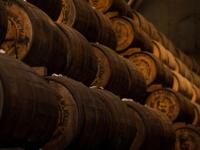The Myth of Phylloxera and the Growth of Whisky
Contents

The myth
The long-held belief among Scotch whisky experts posits that the devastation of the French wine industry by the North American insect Phylloxera in the 19th century led to brandy shortages, driving the English upper crust to embrace Scotch whisky. This shift is often credited with elevating Scotch to its esteemed reputation today. The myth paints a picture of a direct correlation between the Phylloxera crisis and the rise of Scotch, with the insect’s destruction of French vineyards leading to an immediate increase in whisky consumption.
The Truth about whisky & phylloxera
The detailed history of Phylloxera’s impact on the French wine industry, the efforts of individuals like T.V. Munson in combating the crisis, and the complex relationship between wine and whisky consumption reveals that the myth oversimplifies a multifaceted reality.
-
Firstly, the rise of Scotch whisky predates the Phylloxera epidemic. As of 1825, whisky consumption in Britain was already significantly higher than that of brandy. Various factors, such as the Excise Tax of 1823, the Spirits Act of 1860, technological advancements like the Coffey column still, and marketing efforts, played a more substantial role in popularizing Scotch whisky.
-
Secondly, the Phylloxera crisis was not a singular event but part of a series of plagues that affected French vineyards. The French wine industry’s recovery involved complex scientific, agricultural, and cultural efforts, including the grafting of American rootstock onto European vines, a practice pioneered by T.V. Munson.
-
Finally, the notion that English gentlemen’s preferences could sway public drinking habits is questionable. The connection between the Phylloxera crisis and the popularity of Scotch whisky among the English upper class is a thin argument that doesn’t hold up to scrutiny.
In conclusion, while the Phylloxera crisis is an essential chapter in the history of wine and viticulture, its direct impact on the growth of Scotch whisky is more myth than fact. The relationship between these events is nuanced and cannot be reduced to a simple cause-and-effect narrative. The real story involves a rich tapestry of historical, cultural, and technological factors that shaped the alcoholic beverage landscape during that era.
Phylloxera
Phylloxera, a tiny yellow insect, has been both a curse and a blessing in the world of alcoholic beverages. While it devastated vineyards and nearly wiped out the wine industry in the late 19th century, it also inadvertently played a vastly over-exagerated but interesting role in the growth of whisky. Phylloxera, a microscopic insect, violently attacked the roots and leaves of grapevines, sucking the sap until they were dry and dead. Originating in the United States, it spread to Europe in the 19th century, causing widespread devastation. The insect nearly left the world without wine, but human resilience, cooperation, and innovation saved the industry.
In France, one of the regions hit was Cognac, known for its fine brandies. The epidemic wiped out most of the vineyard and livelihoods, leading to a traumatic period for winemakers and vineyards worldwide. The solution came from America, where French plants were grafted onto American root stock, more resistant to Phylloxera.
The Impact on French Wine
By 1878, the invasion had killed over 915,000 acres, representing more than 25% of France’s vineyard acreage. Panic ripped through France, with thousands of vintners fleeing the country. The cure for Phylloxera came through American rootstocks grafted onto Europe’s Vitis vinifera vines. Different regions required different approaches, and French scientists tested thousands of grafting combinations to find the most resistant vines (source).
The Rise of Whisky
While the wine industry was grappling with Phylloxera, the whisky industry saw an opportunity. To suggest that the decline in wine and brandy production led to an increase in whisky consumption would almost certainly be true as brandy drinker shifted to alternate spirits. However to suggest that the Phylloxera crisis caused the surging popularity of whisky is to vastly underestimate how much whisky was being consumed relative to brandy.
Conclusion
The Phylloxera epidemic is a fascinating chapter in the history of alcoholic beverages. While it brought the wine industry to its knees, it is an exageration to say that it opened doors for the whisky industry. The real story is a rich and complex tapestry that involves scientific innovation, cultural shifts, and economic factors. While the Phylloxera crisis undoubtedly played a role in the history of alcoholic beverages, attributing the growth of Scotch whisky solely to this event is a reductionist view that doesn’t hold up to detailed scrutiny. The myth, though enduring, is a simplified interpretation of a complex historical landscape.
Previous

